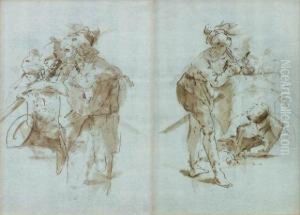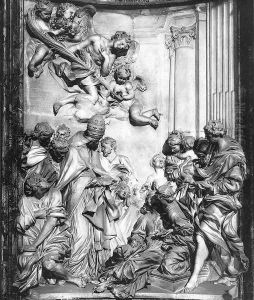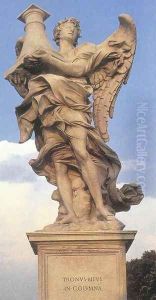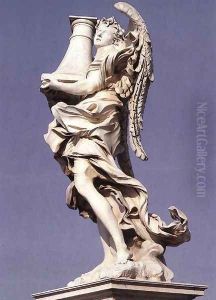Antonio Raggi Paintings
Antonio Raggi, also known as Antonio Lombardo, was an Italian sculptor of the Baroque period, born in 1624 in Vico Morcote, near Lugano, at that time part of the Duchy of Milan, but today located in Switzerland. He moved to Rome relatively early in his life, where he became one of Gian Lorenzo Bernini's most talented pupils and a significant figure in the Roman art scene of the 17th century. Raggi's work is characterized by its dynamic forms, intricate details, and the emotional depth typical of Baroque art.
During his career, Raggi collaborated closely with Bernini, contributing to several of the master's projects. His ability to infuse marble with a sense of movement and his skill at rendering delicate textures were remarkable. Among his most notable works are the Angel with the Crown of Thorns and the Angel with the Superscription for the Ponte Sant'Angelo, directly commissioned by Bernini. These works showcase Raggi's talent in capturing the essence of spiritual themes with a dramatic flair.
Raggi's other significant contributions include the Baptism of Christ in the chapel of the Chigi family in Siena, the decoration of the Chapel of the Blessed Sacrament in San Francesco a Ripa, and the Transverberation of Saint Teresa in the church of Santa Maria della Vittoria in Rome. Each project exemplifies his ability to work with different materials, such as marble, bronze, and stucco, demonstrating versatility and creativity.
Despite his considerable output and the high quality of his work, Antonio Raggi is often overshadowed by the more famous Bernini. However, his contributions to the development of Baroque sculpture in Rome are undeniable. Raggi's works are characterized by a combination of emotional intensity, technical prowess, and a keen sense of movement and drama, which make him a significant, though sometimes underappreciated, figure in the history of art.
Antonio Raggi passed away in Rome in 1686, leaving behind a legacy that is still admired by art historians and enthusiasts. His sculptures continue to be studied for their artistic and historical significance, offering insight into the complexities of Baroque art and its ability to convey profound religious and emotional themes.



